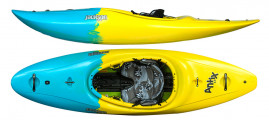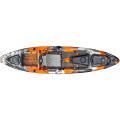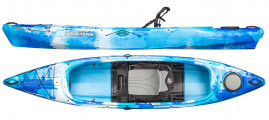Jackson Kayak was founded in 2004 by Olympic champion and professional whitewater paddler, Eric Jackson. At its inception, the company focused exclusively on building top-notch whitewater kayaks for the whole family. Eric Jackson gave special attention towards making a properly fitted youth whitewater kayak, so his kids could shred rivers with him.
Since then, Jackson Kayak has become well-known for building innovative river runners, creek boats and playboats used on moving water around the world. They’ve also expanded their focus to include recreational and fishing kayaks, becoming leaders in the pedal drives that dominate fishing kayaks today. Eric Jackson stepped down as head of the company in 2019, but Jackson Kayaks continues to innovate and build boats for spending quality time on the water.
Today, you’ll find a Jackson Kayak that matches any of your river paddling or calm water desires. Whether you’re doing laps at the local wave, tossing lines to lunkers or exploring a lazy river, there’s a kayak for you. Jackson Kayaks are intended for enjoying whitewater rivers, or gentle inland waterways. Jackson doesn’t presently make any dedicated touring kayaks.
Their whitewater boats are good options for beginner to experienced paddlers, with models suitable for easy Class I to advanced Class V rivers. Jackson recreational kayaks better suit beginner and casual paddlers. Consider these if you prefer flatwater and want a stable, reliable kayak for short tours. Jackson fishing kayaks are super-stable for stand-up fishing and range from simple paddle-powered boats to pedal-driven kayaks loaded with features.
This article will help you choose the right Jackson Kayak for your paddling aspirations. Here, we’ll give an overview of the types of kayaks available, as well as some tips for buying new and used Jackson Kayaks. You’ll also find links to curated lists and specific models, including detailed information and reviews for each.
Shop for Jackson kayaks
Ready to jump straight to the kayaks? Use the links below to view every Jackson Kayak on the market in our Paddling Buyer’s Guide. Here, you’ll have access to important information about each kayak, including its specifications, prices, reviews and where to buy Jackson Kayaks.
Top picks: Best Jackson kayaks for 2024
The following Jackson kayaks have received the highest star ratings by reviewers in our Paddling Buyer’s Guide. See and review all Jackson kayaks here.
Best Jackson Kayaks
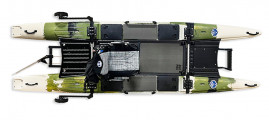
Blue Sky Boatworks 360º Pro
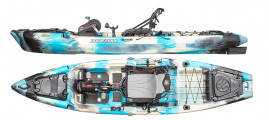
Coosa FD

Blue Sky Boatworks Angler 360º

YuPIK
Shopping for a used Jackson kayak?
You might have some luck finding a used Jackson Kayak. These durable plastic kayaks last a long time, and Jackson’s whitewater designs have stood the test of time, making them popular for collectors. Occasionally though, a secondhand Jackson Kayak will pop up on used classifieds pages or in paddling groups.
Knowing where to look is the first step to finding a used Jackson Kayak. Once you track down a model that suits your needs, you’ll want to give the kayak a thorough inspection and pay a fair price for it.
Where to look
When you first start searching for a used Jackson Kayak, Craigslist, Kijiji or other online classifieds are good initial resources. Also, consider checking specialty sites like MEC Gear Swap for whitewater kayaks or Boat Trader for fishing kayaks. Reach out to community paddling groups; some people may be willing to sell boats they haven’t yet posted.
Symposiums, whitewater festivals and courses, and trade shows are good ways to learn more about different kayaks from experts. If the event is held outdoors, you may also be able to try the kayaks out. Dealers sometimes use these shows to clear out demo models or old stock at a discounted price.
What to look for
Check the kayak’s year if you can. Until 2009, Jackson Kayaks used cross-link polyethylene when making their kayaks. This material was stiffer and lighter than the linear polyethylene used for most kayaks now, but a significant drawback is that you can’t weld cross-link polyethylene. That means that any cracks or holes in a pre-2009 Jackson Kayak have given it a death sentence.
Stay clear of any damaged hulls on boats from that era. Remember that they are strong, though. If you find one that appears to be in good condition, it will likely last you a long time—if it’s been properly cared for.
Proper care for a kayak mainly involves storage and transportation. Damaging UV rays from direct sunlight degrade plastic kayaks quickly, so look for kayaks that have been stored indoors or at least in a shaded area. Avoid kayaks with signs of obvious fading.
If you’re looking at a Jackson Kayak that has been discontinued, there are still ways to find information about the boat. Jackson keeps “Legacy” pages for all of their discontinued whitewater kayaks, recreational/day touring kayaks and fishing kayaks with specs and descriptions of models that are no longer sold. If you need replacement parts for any of these kayaks, contact the company and they can help source them or recommend alternatives.
What to pay
It’s tricky to judge what’s a fair price these days. Traditionally, kayaks held their value exceptionally well and rarely sold for less than half their original price. With supply chain shortages and increased demand for recreation equipment, used kayaks are dealing for almost the same price as new. If you’re desperate for a boat, and a used one is the only option, you might have to pay that price.
On the other end of the spectrum, you may find whitewater kayaks selling for a fraction of their original price—likely because they’ve been used heavily. These kayaks will sell for less than $500. If there are no significant cracks through the hull, the kayak is likely still usable.
For more tips on what to look for when selecting a used kayak, read our article How To Buy A Used Kayak.
Jackson kayak buying guide
Finding the right kayak starts with understanding the type of kayaking you want to do. It’s important to get a style and model that closely suits your intended use. Jackson Kayak builds boats for whitewater, fishing and recreation. We’ll briefly run through the current models of Jackson Kayaks and what they’re best suited for here. See if any of them resemble the type of kayaking you aspire to do.
Whitewater kayaks
There are currently eight different whitewater boats from Jackson Kayaks, three of which are youth models. The Fun 1 and Fun 1.5 are some of the smallest kayaks on the market. These scaled-down playboats are great for getting kids comfortable on the water before they are big enough to handle a full-size kayak. The Sidekick is a river running kayak built for kids 30-100 lbs. This confidence-builder has high sidewalls for extra stability, and is longer for more efficient downriver paddling.
Jackson Kayak’s adult whitewater range offers a model for every type of river paddling. The Rockstar V is a premier playboat used by competitive whitewater paddlers as well as those just looking to play the river. The Antix and Zen are both great options for beginner whitewater paddlers. The Zen is more forgiving and stable with a higher volume, while the Antix feels more playful with its low-volume stern.
If you crave speed, the Nirvana is an accessible whitewater racing kayak that’s at home on everything from beginner whitewater to the most demanding rapids. Finally, Jackson’s Karma Traverse 10 is an interesting crossover kayak that’s worth discussing under the Whitewater category. Featuring a drop-down skeg for enhanced tracking (straight line travel), the Traverse is reasonably quick and efficient when paddling flatwater, but is also capable of paddling up to Class III rivers.
Fishing kayaks
Jackson Kayak’s line of angling kayaks includes boats for fishing everything from ponds to open water. Some models offer pedal- and power-drive options to increase your paddling range. Most Jackson fishing kayaks are sit-on-top style. Sit-on-tops are self-bailing and exceptionally stable, often steady enough to stand on. These are best for fishing anywhere that you would not feel comfortable swimming to shore in.
The other option, sit-inside kayaks, are great for calm waters with ready access to shore. They are also faster and lighter than sit-on-tops, making them equally good options for paddlers who don’t focus exclusively on fishing. There is currently only one sit-inside fishing kayak available, the popular Jackson Kilroy.
Jackson sit-on-top fishing kayaks range from the basic Bite Angler to the fully loaded pedal-drive Coosa FD. In between, there are different models and pedal/power options. You’ll want to consider length and stability when you are looking at different kayaks. Length is often a good indicator of the kayak’s speed. If the same design was built in two different lengths, the longer of the two would be faster.
The longest solo kayak, the Coosa HD, is suitable for open-water paddling. Shorter kayaks like the Bite Angler are more at home in sheltered waters. The Coosa, Jackson Kayak’s flagship fishing model, was designed to be stable enough to stand on but nimble enough to run whitewater.
Models with “FD” in their name have Jackson’s Flex Drive 360 pedal/power option. To use the pedals, the angler cycles their legs like riding a bike, which leaves hands free for fishing. You also have the option of swapping the pedal drive out for an electric motor.
A particularly innovative aspect of the Flex Drive is the automatic retraction. In shallow waters, the propeller will kick up to prevent damage. This is a practical feature in a fishing kayak, especially for someone who regularly fishes shallow water. Not all pedal-driven boats from other brands have equivalent technology.
When you’re buying a fishing kayak, consider its weight. With all the outfitting, these boats are heavier than standard kayaks. A great piece of buying advice is “the best kayak is the one you will use.” You’ll want to be sure you have a method of transporting it, whether it’s by trailer, roof rack or a kayak cart. If moving your kayak is a pain, you’re less likely to use it.
Recreational kayaks
Jackson’s recreational kayaks suit casual paddlers who just want to get on the water for a few hours and have fun. These kayaks are wide and stable. Like Jackson’s fishing kayaks, there are sit-on-top and sit-inside styles available. The Tupelo and Tripper models are stable and comfortable sit-inside kayaks for casual and beginner paddlers. With relatively high volume, these kayaks are good for bringing along small dogs or kids.
The Riviera, Staxx and Cobra are all good sit-on-top kayaks for under $1,000. They have varying levels of outfitting and customization, with the Riviera being the most basic (and cheapest). Molded in foot rests or easily adjustable foot pegs make these good kayaks to share amongst family members. Jackson’s TakeTwo is a great family boat, as it can be configured for tandem or solo paddling. It’s also available in an angler version, which comes with accessory tracks for mounting rod holders, fish finder, action cameras and more.
Use this as a start, and remember that online research will only get you so far. The best advice we can offer is to always test paddle before buying any boat. The more time you can spend on the water in a similar style of kayak, the better the purchasing decision you will make.
Here are answers to some of the most common questions about Jackson kayaks.
-
Are Jackson kayaks good?
Jackson Kayaks build a range of quality kayaks, so there’s a strong chance one of them will be a good match for the type of paddling you want to do. Jackson Kayaks was founded by whitewater kayakers; an understanding of hydrodynamics—how water moves—is fundamental to building high-performing whitewater kayaks.
This philosophy and knowledge carries into Jackson’s fleet of fishing and recreational kayaks. The most important thing when shopping for a kayak is to know how you want to use it. Each kayak is specialized for a specific environment, so find one that meets your needs.
-
Jackson kayak models
Jackson Kayak models change each year, with new ones introduced and older ones phased out. Contact the company directly for support or replacement parts on kayaks they no longer offer. View all of the current Jackson Kayak models in the Paddling Buyer’s Guide.
-
Jackson kayak specs
With fishing kayaks, in particular, pay attention to the weight listed in the Jackson kayak specs. On pedal-driven kayaks, the weight provided may not include the Flex Drive system. Check the specs for each Jackson Kayak in the Paddling Buyer’s Guide.
-
Jackson kayak weight limit
The weight limit of Jackson Kayaks varies depending on the specific model. Weight limit, or capacity, refers to the total weight that the hull can handle. This includes the user, the gear you’re bringing and any additional features added like the Flex Drive 360 system. Check the specs for each Jackson Kayak in the Paddling Buyer’s Guide.
-
How much is a Jackson kayak?
Jackson Kayaks range from $699 USD to $3,599 USD, depending on the model. Their cheaper recreational sit-on-tops are a fair price for a quality rotomolded kayak. Jackson Kayak prices and quality are comparable to other respected brands such as Wilderness Systems, Perception and Dagger.
-
What are Jackson kayaks made out of?
Jackson Kayaks are made with polyethylene plastic, and the metal components use marine-grade aluminum. A telling feature of Jackson Kayaks’ quality is the commitment to building a “dry” boat—most of their kayaks do not have any components drilled through the hull, aside from the drain plug, of course. This eliminates potential points of entry for water to leak.
-
Are Jackson kayaks rotomolded?
Jackson Kayaks are rotomolded and made with high-density polyethylene. The rotomolding process results in a strong kayak. This is a standard method of building plastic kayaks as it is relatively inexpensive, keeping the overall kayak cost low.
-
Jackson kayak dealers
Jackson kayaks are sold through their website and independent dealers. Find where to buy Jackson Kayaks by visiting the Paddling Buyer’s Guide and selecting “Buy Local.”
-
Jackson kayak financing
Jackson Kayaks have partnered with Klarna to offer financing options on any of their products. With Klarna, buyers can spread their payments out over time.
-
Who owns Jackson kayak?
Eric Jackson and designer David Knight founded Jackson Kayak in 2004. In 2019, Eric Jackson stepped down from the President role and Peter Hausin took over as CEO.
-
Does Dane Jackson own Jackson kayaks?
Dane Jackson is one of the best whitewater paddlers in the world, and is a member of Jackson Kayak’s pro team. He is the son of Jackson Kayaks’ founder, Eric Jackson.
-
Does Eric Jackson own Jackson kayaks?
Eric Jackson owned Jackson Kayaks until late 2019. He has since stepped down to spend more time on the water instead of in the boardroom.
-
Where is Jackson kayak located?
Jackson Kayak’s headquarters is located near Rock Island, Tennessee. All of their kayaks are built in their Sparta, Tennessee, manufacturing facility.
-
Where are Jackson kayaks made?
If you’re wondering, Are Jackson Kayaks made in the USA? The answer is yes, all of their kayaks are built in Sparta, Tennessee.
-
What happened to Jackson kayak?
Founded in 2004, Jackson Kayak originally focused exclusively on making whitewater kayaks. Since then, Jackson Kayak has expanded to add fishing and recreational kayaks to their lineup. Under the new umbrella of Jackson Adventures, they also build Orion coolers and kennels and have purchased Blue Sky Boatworks, which make pontoon-style fishing platforms.
Alongside these changes, Jackson has scaled back some of their offerings, only distributing select whitewater models. For competitions or large outfitter orders, they custom build batches of legacy models.
Compare Jackson kayaks
-
Native vs Jackson kayak
While Jackson Kayak’s fishing kayaks prioritize performance, Native kayaks focus on stability. Their fishing line is targeted towards bass fishing. Native offers super-stable, square-sterned boats that can be equipped with pedal or motor drives. The Native Falcon is a fishing kayak loaded with features for a reasonable price. Their higher-end models like the Slayer Max or Titan are designed for bass fishing on calm, fresh or salt waters.
Jackson fishing kayaks like the Coosa and BigRig can handle more challenging conditions like current or swell. Jackson also offers more paddle-powered fishing kayak options, and a sit-inside fishing kayak, the Kilroy. Both brands boast about the comfort of their seating systems (nearly every kayak maker does).
Choosing between these systems is mainly personal preference, and trying the boat out is the best way to get a sense of their comfort.
-
Pelican vs Jackson kayak
The Quebec-based kayak brand Pelican is ubiquitous with recreational boats for cottage lakes, campgrounds and waterfronts around North America. They are distributed through large retailers like Costco, Canadian Tire and Walmart. Pelican makes sit-inside and sit-on-top kayaks for casual users and fishing kayaks that, like Jackson, can be rigged with pedal and motor power. Pelican’s stubby, wide rec kayaks are as stable as barges, and many are priced under $600, cheaper than most Jackson kayaks.
Most of their mid-range kayaks are lighter than Jackson Kayaks because of their RAM-X polyethylene construction. Jackson Kayaks focus more on performance and craftsmanship. Their kayaks are heavier than Pelican kayaks, but without any holes drilled into the hull, the robust one-piece construction is built to last.
Jackson fishing kayaks like the BigRig and Coosa are much more suitable for challenging environments. If you’re staying on flat water and buying on a budget, a Pelican is fine. For more of a performance-oriented kayak, choose a Jackson Kayak.
-
Jackson kayak vs Wilderness Systems
Wilderness Systems have been making kayaks for several decades. Today, their range is mostly fishing, recreational and some touring models. They are priced comparably to Jackson Kayaks. Jackson doesn’t make equivalents to Wilderness Systems’ touring and sea kayak models, and Wilderness Systems also makes more deluxe sit-inside recreational kayaks like the bestselling Pungo.
If you’re looking for a feature-rich recreational sit-inside or a touring kayak, check out Wilderness Systems. For a whitewater boat, look at Jackson Kayaks. Both companies make high-quality fishing kayaks. Compare specific models in their lineups to find the one that best matches your needs or preferences.
-
Jackson kayak vs Bonafide
Bonafide kayaks is a newer company with bold plans for its fishing models. They have a small line of fishing kayaks for inshore and offshore fishing. Bonafide sticks to paddle or motor-driven kayaks, but the motor needs to be purchased separately. This keeps their costs lower, but Bonafide boats still have all the basics of a premium fishing kayak. Jackson Kayak owners with the Flex Drive system can choose paddle, motor or pedal power, distinguishing them from Bonafide boats.
Jackson’s Big Tuna fishing tandem is also unmatched by Bonafide for capacity or versatility in seating options. Models that are comparable across both brands would be Bonafide’s RS117 and Jackson’s Bite Angler. Consider the type of kayak fishing you’ll be doing, and it may help narrow down your search. If you’re keen on a pedal drive or motor power, choose a Jackson Kayak. If you aspire to offshore fishing, look at some of Bonafide’s kayaks.
-
Jackson kayak vs NuCanoe
NuCanoe fishing kayaks offer easy swaps between paddle, pedal and motor power. The power drives for these kayaks are at the stern rather than Jackson’s drive from mid-boat. While stern placement may protect the system a bit more, Jackson Kayak’s pedal- or motor-power Flex Drive is designed to retract on impact with an underwater obstacle, making it suitable for shallow water fishing.
NuCanoe’s products are offered with base models and a series of add-ons. If you’re looking for a bare-bones kayak for fishing and hunting in calm water, choose a NuCanoe. For more tailored designs with ready-to-fish builds, look to Jackson’s fishing kayaks. Jackson also offers sit-inside style fishing kayaks, as well as recreation and whitewater boats.
-
Jackson kayak vs Old Town
Maine-based Old Town Canoe and Kayak builds rotomolded recreational and fishing kayaks for casual anglers and paddlers. Their recreational kayaks are mostly sit-inside style kayaks, leaving the sit-on-tops to their sister company Ocean Kayak. Old Town also offers touring kayaks like the Castine and a longer sea kayak, the Looksha 17. These are good options if you want a kayak with bulkheads (interior walls within the hull that ensure flotation if the kayak swamps) so you can travel off-shore safely.
For whitewater or river travel, you’re better off with a Jackson Kayak. Their experience building whitewater kayaks carries over into the highly rockered hull shapes of the Coosa, making even their fishing boats handle well in moving water. Comparing the two brands’ fishing kayaks, Jackson’s Flex Drive pedal system shines in shallow water as it automatically retracts on impact with underwater obstacles.
Old Town’s award-winning Sportsman Series kayaks with pedal- or motor-power options are high-end fishing kayaks that dominate in flatwater and are worth any serious angler’s consideration.
-
Hobie vs Jackson kayak
Hobie makes sit-on-top recreational and fishing kayaks that exclusively use their signature Mirage pedal-drive system. This system involves a stepping motion rather than the cycling motion found on most other pedal-driven kayaks. Like Jackson’s Flex Drive, the Mirage system also retracts on impact with underwater obstacles, a useful feature for shallow water exploration.
Hobie offers more variety for recreational sit-on-tops, and their kayaks have many different add-on options like “bimini” sun shades, sailing kits or custom carrying carts. Hobie’s iTrek line of inflatable pedal drive kayaks are great options for anyone tight on storage space.
Choose a Jackson kayak if you are looking for performance in moving water, or you want a traditional paddle-powered or sit-inside kayak. Opt for a Hobie if you want an inflatable or you’re keen on an efficient pedal-drive kayak for fun or fishing.
-
Vibe vs Jackson kayak
Vibe builds sleek fishing kayaks to which you can add either pedal or motor power. These options are add-ons; the basic kayak can be purchased for strictly paddling. The Vibe Cubera Hybrid is a kayak/paddleboard combo for anglers who want a stand-up perspective. Vibe’s X-Drive pedal system uses two fins rather than a propeller to move. The user pushes their feet back and forth rather than a cycling motion like Jackson’s Flex Drive pedal system.
If you prefer this stepping motion, look at Vibe’s kayaks. If you plan on fishing in shallow areas, Jackson’s Flex Drive retracts to prevent damage from underwater obstacles. Jackson also makes recreational sit-on-top kayaks that can be used for casual paddling and angling. If you aren’t looking for a full-fledged fishing kayak, or prefer the Flex Drive, look at Jackson Kayaks.
-
Jackson kayak vs Feelfree
North Carolina-based Feelfree makes plastic recreational, touring and fishing kayaks at very affordable prices. Their recreational designs meet the basic requirements of casual paddlers, and their 14-foot touring kayak costs under $1,000 USD, a price almost unheard of in this kayak class. Jackson makes comparable recreational kayaks but does not currently make touring kayaks.
The flagship Feelfree Lure 13.5 has loads of stability and is a true sit/stand fishing kayak. FeelFree kayaks can be outfitted with their Overdrive system, which like Jackson’s Flex Drive, allows paddlers to alternate between pedal and motor power. FeelFree kayaks have an integrated wheel in the stern, so the owner can pull the kayak from the bow on flat, solid surfaces without lifting its entire weight. If you only plan on transporting your kayak in paved areas like a concrete boat launch, this is a good feature.
If you are dragging it across sand or rough terrain, don’t expect to rely on the stern wheel. Jackson Kayaks are a bit pricier but are built in the USA using quality polyethylene and rigorous quality control. If you spend a bit more money upfront, you’ll get a kayak that will last. FeelFree’s recreational kayaks are suitable for short outings, but look to Jackson Kayaks for more comfort for long days in the seat.
Jackson kayak reviews
Read reviews to get an in-depth understanding of how Jackson Kayaks perform. These are the next best thing to actually paddling the boat for yourself. Pay attention to the details the reviewer describes; how the kayak fits or handles in certain conditions is telling. Also, compare the type of paddling that you’ll do to what the reviewer describes. Don’t be put off by criticisms—these just show that the review is fair and balanced. Instead, decide if they are things that would be deal-breakers for you or not.
- Whitewater Kayak Review: Jackson Kayak Flow
- Whitewater Kayak Review: Jackson Antix 2.0
- Boat Review: Jackson Zen Kayak
- Boat Review: Jackson Rogue 10 Kayak
- Boat Review: Jackson 2 Fun Kayak 2015
- Creek Boat Review: Jackson Kayak Villain




